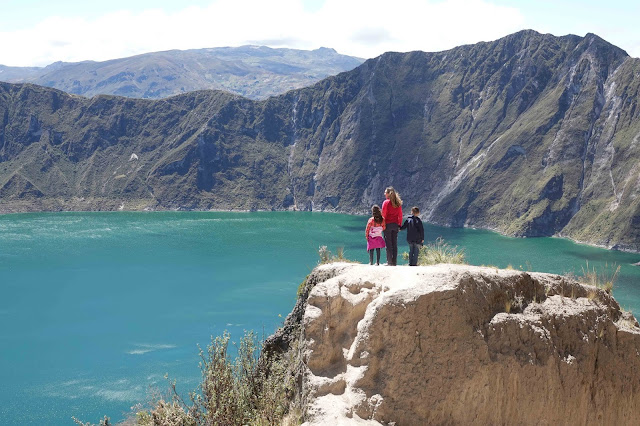From Shell we took the bus to Latancunga and then a taxi to Quilotoa. The 3 hour bus ride gave us time to watch the entire live-action version of Tarzan. We were relieved at the movie choice as our Ecuadorian bus experiences in the past have included very inappropriate movies (strippers and graphic gun violence).
We paid $20 for a beautiful 2 hour drive from Latancunga to Quilotoa. Shades of green and brown patchwork quilt terrain stretched over hills, mountains and valleys, is really a sight to behold. Though if you are prone to car sickness, prepare yourself as the only road in is super windy and involves passing slower vehicles on narrow roads. In hindsight we should have noticed the racing sticker on our driver's windshield, but I didn't until the wheels were squealing as heaped through the curves. Now imagine you have PTSD from a vehicle accident that occurred along a curve! Whew, I don't know how Daddy made it thru that drive.

The woman below is wearing traditional clothing of the highland Quechua,
Back at Hostal Chukirawa, Daddy had begun teaching the kids to play chess. They picked it up super fast. Afterwards we settled into our room as it warmed with our own wood-burning stove.

We chose to take the easy way up by riding horses to the rim for $10 each. We were impressed by not only the horses, but the men and women who accompany the horses up and down the crater. The two men who kept our horses in line kept up with us on foot. They told us they go down and back twice a day! Quite a strenuous job.
For a bigger adventure, there is a 6 mile rim trail and a 19 mile Quilotoa Loop trail that you can hike. It takes 3-4 days and there are hostels along the route for overnight stays and meals. Initially the rim trail sounded like a good idea, but now that I've experienced the strong, cold winds along the rim and seen the narrow trail, I'm not sure that I would enjoy that. Many people get lost on the loop trail, so if you are thinking of attempting it, I suggest doing a lot of research during the planning stage.
Next stop Cotopaxi National Park.

































No comments:
Post a Comment